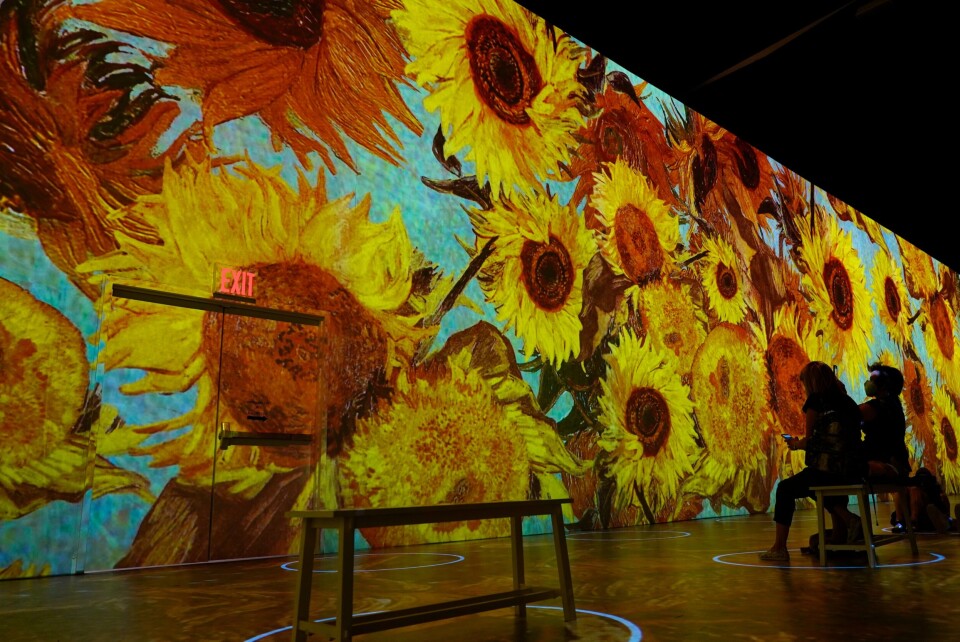-
French innovation leads development of electric planes
Five innovative projects aim to revolutionise air travel by 2026
-
Chauvet cave in south of France is slowly revealing its secrets
3D technology is revolutionising our understanding of 36,000-year-old paintings in the Chauvet Cave in Ardèche
-
How does France’s April Fools’ Day differ from that in UK or US?
It is in schools where we see a real French peculiarity
'Paintings from Van Gogh were not designed to float around people'
Philosophers express concern over immersive art. Does it dumb down masterpieces and make us more anti-social?

The art scene has been on high alert for the last few years as exhibitions and art galleries have jumped on the bandwagon of ‘immersive art’, a phenomenon in which visitors experience artworks through immersive techniques.
Visit a digital Venice in Paris
‘Venise révélée’ (‘Venice Revealed), the latest exhibition in the Grand Palais in Paris from September 2022 to February 19, 2023, is the trendiest such event in France for the coming art scene season.
The digital display takes visitors inside the Italian city’s jewels thanks to 3D modelisation and a partnership with a French video-game company using models from the game Assassin’s Creed to amplify the public’s sense of immersion.
Read more: Experts approve controversial changes for Notre-Dame cathedral
Experience immersive art exhibitions
Other exhibitions in September include ‘Optimisme ambient’ at Les Subsistances arts venue in Lyon, from September 14 to September 18, ‘JAM Capsule’ at Paris Expo or regulars of l’Ateliers des Lumières.
L’Ateliers des Lumières is known for being at the forefront of immersive art displays, the art centre having organised the first festival dedicated to immersive art in Paris in 2019.
Access exhibitions in your home
Immersive art differs from the traditional experience at arts shows, galleries, museums and painting events in which silence, concentration and memory rule.
Foundations and festivals tie-in their exhibition to adapt to social media platforms or turn to partnerships with content creators on Twitch, an interactive live streaming service, with people having access to exhibitions directly from their home.
Malian artist exhibits with Instagram in mind
“Several exhibitions are designed to be Instagram-compatible,” said Victoria Le Boloc’h-Salama, creator of the podcast ‘Le Bruit de l’art’, art critic and head communication at the Institut national de l’Histoire de l’Art in Paris.
Ms Le Boloc’h-Salama particularly mentioned ‘Mali Twist’ at the Fondation Cartier, an exhibition of Malian photographer Malick Sidibé between October 2017 and February 2018, in which an area of the exhibition was designed so that people could take pictures as if they were portrayed by the artists’ work and to be featured on Instagram.
Criticism of the technology
Immersive art, though, has its fair share of criticism within the industry and among philosophers.
Philosophers Yves Michaud and Daniel Bougnoux denounced it as an art form mirroring a greater societal change itself, in which technology allows people to ‘abandon themselves’ through concepts of personal experience, feeling and passive experience.
“Our modern society is immersive where we constantly bring background, experience and perception into the equation,” said Mr Michaud, the former director of the Ecole nationale des Beaux-Arts from 1989 to 1997.
“Immersive art is the image of what a restaurant has become. People go there to be seen, soak up the atmosphere and take pictures rather than to eat,” he added.
The quote somehow aligns with articles from restaurant owners who admitted to focus more on the aesthetics of the plate than the taste itself to boost social media presence and traffic.
‘Van Gogh paintings were not designed to float around people’
The increasing number of immersive art exhibitions in London has had Time Out magazine question whether people needed a return to “shared moments in an increasingly fractured, digital world.”
The phenomenon is the reflection of a current hedonistic society that likes to live in its own comfort bubble, said Mr Michaud, adding that technology gave an access door to escape daily struggles and the hardships of reality.
Critics have also raised questions around the devaluation of original masterpieces, pointing out that paintings from Vincent Van Gogh were not designed ‘to float around people.’
This was a reference to the art show at the Atelier des Lumières in Paris from 2019 to 2020.
Mr Michaud said that art had other immersive periods throughout history, listing the Rococo painting period, and still hoped the immersive art boom will see new art forms favouring a return to former practices.
“I still hope immersive art is the froth of days from which something radically different will emerge. After the Rococo period came the classicism period,” said Mr Michaud.
Related articles
Emmy award for French company whose tech was used in Game of Thrones
Serge Gainsbourg’s Paris home to open to the public in spring
Explore the Côte d’Azur in miniature in France's latest exhibition
























